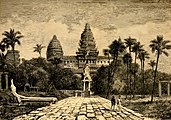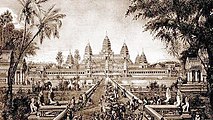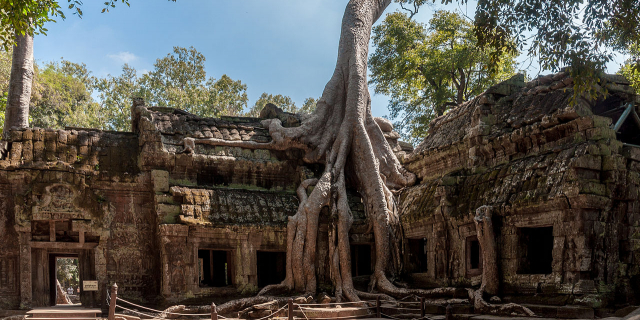ប្រាសាទ អង្គរវត្ត
( Angkor Wat )
Angkor Wat (; Khmer: អង្គរវត្ត, "City/Capital of Temples") is a Hindu-Buddhist temple complex in Cambodia, located on a site measuring 162.6 hectares (1,626,000 m2; 402 acres). It resides within the ancient Khmer capital city of Angkor. The Guinness World Records considers it as the largest religious structure in the world. Originally constructed as a Hindu temple dedicated to the god Vishnu for the Khmer Empire by King Suryavarman II during the 12th century, it was gradually transformed into a Buddhist temple towards the end of the century; as such, it is also described as a "Hindu-Buddhist" temple.
Angkor Wat was built at the behest of the Khmer King Suryavarman II in the early 12th century in Yaśodharapura (Khmer:
Angkor Wat (; Khmer: អង្គរវត្ត, "City/Capital of Temples") is a Hindu-Buddhist temple complex in Cambodia, located on a site measuring 162.6 hectares (1,626,000 m2; 402 acres). It resides within the ancient Khmer capital city of Angkor. The Guinness World Records considers it as the largest religious structure in the world. Originally constructed as a Hindu temple dedicated to the god Vishnu for the Khmer Empire by King Suryavarman II during the 12th century, it was gradually transformed into a Buddhist temple towards the end of the century; as such, it is also described as a "Hindu-Buddhist" temple.
Angkor Wat was built at the behest of the Khmer King Suryavarman II in the early 12th century in Yaśodharapura (Khmer: យសោធរបុរៈ, present-day Angkor), the capital of the Khmer Empire, as his state temple and eventual mausoleum. Angkor Wat combines two basic plans of Khmer temple architecture: the temple-mountain and the later galleried temple. It is designed to represent Mount Meru, home of the devas in Hindu mythology: within a moat more than 5 kilometres (3 mi) long and an outer wall 3.6 kilometres (2.2 mi) long are three rectangular galleries, each raised above the next. At the centre of the temple stands a quincunx of towers. Unlike most Angkorian temples, Angkor Wat is oriented to the west; scholars are divided as to the significance of this. The temple is admired for the grandeur and harmony of the architecture, its extensive bas-reliefs, and for the numerous devatas adorning its walls. The modern name Angkor Wat, alternatively Nokor Wat, means "Temple City" or "City of Temples" in Khmer. Angkor (អង្គរ ângkôr), meaning "city" or "capital city", is a vernacular form of the word nokor (នគរ nôkôr), which comes from the Sanskrit/Pali word nagara (Devanāgarī: नगर). Wat (វត្ត vôtt) is the word for "temple grounds", also derived from Sanskrit/Pali vāṭa (Devanāgarī: वाट), meaning "enclosure".
The original name of the temple was Vrah Viṣṇuloka or Parama Viṣṇuloka meaning "the sacred dwelling of Vishnu".
 King Suryavarman II, the builder of Angkor Wat
King Suryavarman II, the builder of Angkor WatAngkor Wat lies 5.5 kilometres (3+1⁄2 mi) north of the modern town of Siem Reap, and a short distance south and slightly east of the previous capital, which was centred at Baphuon. In an area of Cambodia where there is an essential group of ancient structures, it is the southernmost of Angkor's main sites.[citation needed]
The construction of Angkor Wat took place over 28 years from 1122 to 1150 CE, during the reign of King Suryavarman II (ruled 1113–c. 1150).[1] A brahmin by the name of Divākarapaṇḍita (1040–c. 1120) was responsible for urging Suryavarman II to construct the temple.[2] All of the original religious motifs at Angkor Wat derived from Hinduism.[3] Breaking from the Shaiva tradition of previous kings, Angkor Wat was instead dedicated to Vishnu. It was built as the king's state temple and capital city. As neither the foundation stela nor any contemporary inscriptions referring to the temple have been found, its original name is unknown, but it may have been known as Vrah Viṣṇuloka after the presiding deity. Work seems to have ended shortly after the king's death, leaving some of the bas-relief decoration unfinished.[4] The term Vrah Viṣṇuloka or Parama Viṣṇuloka literally means "The king who has gone to the supreme world of Vishnu", which refer to Suryavarman II posthumously and intend to venerate his glory and memory.[5]
In 1177, approximately 27 years after the death of Suryavarman II, Angkor was sacked by the Chams, the traditional enemies of the Khmer.[6] Thereafter the empire was restored by a new king, Jayavarman VII, who established a new capital and state temple (Angkor Thom and the Bayon, respectively), a few kilometers north, dedicated to Buddhism, because the king's new wife, Indratevi, a devout Mahayana Buddhist, encouraged him to convert. Angkor Wat was therefore also gradually converted into a Buddhist site, and many Hindu sculptures were replaced by Buddhist art.[3]
 Early photograph of Angkor Wat in 1866, taken by Emile Gsell
Early photograph of Angkor Wat in 1866, taken by Emile GsellTowards the end of the 12th century, Angkor Wat gradually transformed from a Hindu centre of worship to Buddhism, which continues to the present day.[7] Angkor Wat is unusual among the Angkor temples in that although it was largely neglected after the 16th century, it was never completely abandoned.[8] Fourteen inscriptions dated from the 17th century, discovered in the Angkor area, testify to Japanese Buddhist pilgrims that had established small settlements alongside Khmer locals.[9] At that time, the temple was thought by the Japanese visitors to be the famed Jetavana garden of the Buddha, which was originally located in the kingdom of Magadha, India.[10] The best-known inscription tells of Ukondayu Kazufusa, who celebrated the Khmer New Year at Angkor Wat in 1632.[11]
 Carving of Vishnu churning the sea of milk[citation needed]
Carving of Vishnu churning the sea of milk[citation needed] Monks in front of the reflection pool at Angkor Wat, Cambodia
Monks in front of the reflection pool at Angkor Wat, CambodiaThe first Western visitor to the temple was António da Madalena, a Portuguese[12] friar who visited in 1586 and said that it "is of such extraordinary construction that it is not possible to describe it with a pen, particularly since it is like no other building in the world. It has towers and decoration and all the refinements which the human genius can conceive of."[13]
In 1622, The Poem of Angkor Wat composed in Khmer verse describes the beauty of Angkor Wat and creates a legend around the construction of the complex, supposedly a divine castle built for legendary Khmer king Preah Ket Mealea by Hindu god Preah Pisnukar (or Braḥ Bisṇukār, Vishvakarman), as Suryavarman II had already vanished from people's minds.[14]
In 1860, with the help of French missionary Father Charles-Émile Bouillevaux, the temple was effectively rediscovered by the French naturalist and explorer Henri Mouhot, who popularised the site in the West through the publication of travel notes, in which he wrote:
One of these temples, a rival to that of Solomon, and erected by some ancient Michelangelo, might take an honorable place beside our most beautiful buildings. It is grander than anything left to us by Greece or Rome, and presents a sad contrast to the state of barbarism in which the nation is now plunged.[15]
In 1861, German anthropologist Adolf Bastian undertook a four-year trip to Southeast Asia. His account of this trip, The People of East Asia, ran to six volumes. When Bastian finally published the studies and observations during his Journey through Cambodia to Cochinchina in Germany in 1868 – told in detail but uninspiredly, above all without a single one of his drawings of the Angkorian sites – this work hardly made an impression, while everyone was talking about Henri Mouhot's posthumous work with vivid descriptions of Angkor, Travels in the Central Parts of Indo-China, Siam, Cambodia and Laos, published in 1864 through the Royal Geographical Society.[16]
 The grand replica of Angkor Wat at the Paris Colonial Exposition (1931) represented the immense grandeur of the French protectorate of Cambodia.
The grand replica of Angkor Wat at the Paris Colonial Exposition (1931) represented the immense grandeur of the French protectorate of Cambodia.There were no ordinary dwellings or houses or other signs of settlement, including cooking utensils, weapons, or items of clothing usually found at ancient sites.[17]
The artistic legacy of Angkor Wat and other Khmer monuments in the Angkor region led directly to France adopting Cambodia as a protectorate on 11 August 1863 and invading Siam to take control of the ruins. This quickly led to Cambodia reclaiming lands in the northwestern corner of the country such as the areas of Siem Reap, Battambang, and Sisophon which were under Siamese rule from 1795 to 1907.[18][19]
Angkor Wat's aesthetics were on display in the plaster cast museum of Louis Delaporte called musée Indo-chinois which existed in the Parisian Trocadero Palace from c.1880 to the mid-1920s.[20]
The 20th century saw a considerable restoration of Angkor Wat.[21] Gradually teams of laborers and archeologists pushed back the jungle and exposed the expanses of stone, permitting the sun to once again illuminate the dark corners of the temple. Angkor Wat caught the attention and imagination of a wider audience in Europe when the pavilion of French protectorate of Cambodia, as part of French Indochina, recreated the life-size replica of Angkor Wat during Paris Colonial Exposition in 1931.[22]
Cambodia gained independence from France on 9 November 1953 and has controlled Angkor Wat since then. From the colonial period onwards, until the site was nominated a UNESCO World Heritage in 1992, the temple of Angkor Wat was instrumental in the formation of the modern and gradually globalised concept of built cultural heritage.[23]
 Bullet holes left by a shoot-out between the Khmer Rouge and Vietnamese forces at Angkor Wat
Bullet holes left by a shoot-out between the Khmer Rouge and Vietnamese forces at Angkor WatRestoration work was interrupted by the Cambodian Civil War and Khmer Rouge control of the country during the 1970s and 1980s, but relatively little damage was done during this period. Camping Khmer Rouge forces used whatever wood remained in the building structures for firewood, and a shoot-out between Khmer Rouge and Vietnamese forces put a few bullet holes in a basrelief. Far more damage was done after the wars, by art thieves working out of Thailand, which, in the late 1980s and early 1990s, claimed almost every head that could be lopped off the structures, including reconstructions.[24]
The temple is a symbol of Cambodia and is a source of national pride that has factored into Cambodia's diplomatic relations with France, the United States, and its neighbour Thailand. A depiction of Angkor Wat has been a part of Cambodian national flags since the introduction of the first version circa 1863.[25] From a larger historical and transcultural perspective, however, the temple of Angkor Wat did not become a symbol of national pride sui generis but had been inscribed into a larger politico-cultural process of French-colonial heritage production in which the original temple site was presented in French colonial and universal exhibitions in Paris and Marseille between 1889 and 1937.[26]
In December 2015, it was announced that a research team from the University of Sydney had found a previously unseen ensemble of buried towers built and demolished during the construction of Angkor Wat, as well as a massive structure of unknown purpose on its south side and wooden fortifications. The findings include evidence of low-density residential occupation in the region, with a road grid, ponds, and mounds. These indicate that the temple precinct, bounded by a moat and wall, may not have been used exclusively by the priestly elite, as was previously thought. The team used LiDAR, ground-penetrating radar and targeted excavation to map Angkor Wat.[27]
According to a myth, the construction of Angkor Wat was ordered by Indra to serve as a palace for his son Precha Ket Mealea.[28] According to the 13th-century Chinese traveller Zhou Daguan, some believed that the temple was constructed in a single night by a divine architect.[29]



































Add new comment